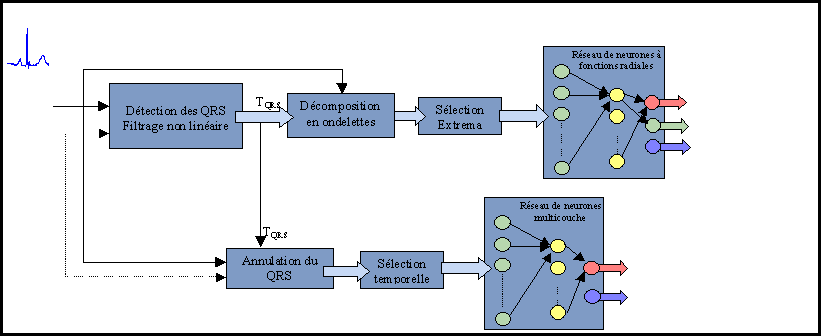
Research > Signal treatment
›› Introduction
The characterization of cardiac arrhythmias and the analysis of cardiac variability necessitates to detect the temporal markers (the QRS complexes, the P and T waves) of the cardiac revolution and to identify the mutual relations among these events. In Intensive Care Units the problem is particularly difficult because the signal may be corrupted by various types of noise (muscular noise linked to patient movements, 50 Hz interference noise, noise linked to unsticky sensors, etc.).
The multiplicity of noise sources explain the high number of research actions that were conducted in the last 20 years, either for QRS or P wave detection, and that go on nowadays.
›› Contributions
In the signal processing field, we have been driven to propose a general approach able to process multivariate signals - ECG, pressure, oesophagian ECG, etc. - by a low level analysis in order to satisfy these goals related to detection, characterization, estimation of temporally structured events.
Complex QRS detection: the detection was tackled essentially under the angle of multichannel detection in Alfredo Hernandez's thesis. The obtained results proved the benefit of sensor association. These results were confirmed by Koulouris. For monosource analysis the work (François Portet's thesis) consisted in comparing several algorithms from the literature and in testing them with respect to the observed rhythm and to the additive noise. The results showed that a piloting strategy must absolutely be implemented in order to optimize the detection performance (see piloting).
P wave detection: this remains a difficult problem in ECG analysis, not only in the presence of noise but also in the contect of arrhythmias of ventricular origin (P wave embedded in the QRS complex). In Alfredo Hernandez and Feng Wang's theses we have proposed several methods for QRS cancellation. They were objectively compared to reference detectors in the domain on standard labeled datasets (MIT-BIH). The measured performance underline their efficiency. The P wave detection was improved by adding a classification stage based on artificial neural networks in ordeer to separate the true from the inevitably false detections. Results on cancellation make a contribution to the effort achieved by several international teams on predicting atrial flutters and fibrillation from surface ECG, since these prediction strategies perform a QRS cancellation before proceeding to any computation.
QRS complex classification: this study have made use of old results established by Lotfi Senhadji in his PhD (1993). He has showed the benefit of representing QRS complexes by the extrema of an orthogonal wavelet decomposition. Our most recent work led to improve the separation capability with the integration of a radial basis funtion neuronalclassifier. Classification rate aroung 90 % were obtained on cardiac beats from 5 different origins (sinus rhythm, ventricular, junctional, sinus rhythm with additional left bundle branch block, sinus rhythm with Kent bundle).
›› Operation
The Figure below gives an animated graphical representation of the research actions. After QRS detection (the detector is chosen by the piloting module), an orthogonal wavelet decomposition is performed and the most significant extrema are kept. They are representative of the QRS complex. They are given as input to a radial basis function neural classifier (on this example the clssifier has to decide whether if the beat originates from sinus excitation or from an extrasystole). Around the detected QRS occurrence, the extrema that contributes to the QRS are omitted in the ECG reconstruction. This way, i) an ECG signal without QRS is generated, ii) then it is easier to detect P waves, even those embedded in a QRS. The (feed-forward) artificial neural net has then to decide between two hypotheses:

|
|
Architecture of the signal processing module |